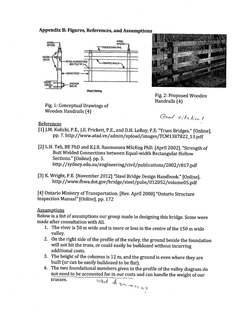Howard
Duan
H
 Appendix A: Calculations |
|---|
 Appendix A: Calculations |
 Appendix A: Calculations |
 Appendix A: Calculations |
 Appendix A: Calculations |
 Appendix A: Calculations |
 Appendix A: Calculations |
 Appendix B: Citations |
 Appendix C: Designs |
CIV Bridge Design Project
In CIV 102H groups of 3 students were asked to respond to a RFP for a pedestrian footbridge 150m long. My group and I followed the guidelines set forth by Prof. Collins in class and designed a 3 span symmetrical bridge that has a slightly longer middle span proportional to both outer spans. This design was finalized after simulating dozens of similar truss plans on the JHU simulator. The simulator allowed us to find the optimal design to carry load. We eventually settled on a sub divided warren design. In the final calculations, we found that the loading was such that the web members had to be of a bigger size than the chord members, this prompted us to use the same sized HSS, thereby increasing the factor of safety for nearly all members.
For all our success at carrying load, we failed to consider other requirements – a consequence of our ignorance of unlisted stakeholders. In designing for safety, we only considered the safety of bearing load, not, as Prof. Foster incisively pointed out in our presentation, other factors, such as human negligence and stupidity should someone climb onto the bridge from the bottom. Safety aside, many other factors were ignored. Therefore, though we thought we had thoroughly met the requirements, we had only met the necessary, without expanding into the sufficient. This project constantly reminds of the importance of the sufficient.
